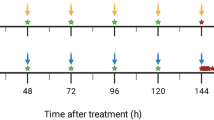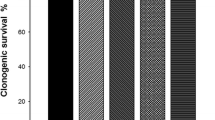Abstract
Objective
To study the pharmacokinetics of neamine in rats and to evaluate its anti-cervical cancer activity.
Methods
The plasma level of neamine was determined by HPLC–ELSD. Pharmacokinetic parameters were calculated using DAS 2.0 software. Tissue microarray analysis was conducted to examine angiogenin (ANG) expression in normal and cancerous cervical tissues and to determine its correlation with clinical and pathologic presentations of cervical cancers. The anti-cervical cancer activity of neamine was assessed both in vitro and in vivo.
Results
After intravenous (i.v.) administration of 15, 30, and 60 mg kg−1 neamine, the pharmacokinetic parameters were as follows: AUC(0–t), 9,398.0 ± 653.4, 19,235.2 ± 2,939.0, and 35,437.7 ± 3,772.2 mg L−1 min; C max, 170.8 ± 13.1, 353.3 ± 15.8, and 464.0 ± 33.1 mg L−1; T 1/2, 34.9 ± 4.1, 46.8 ± 5.1, and 58.0 ± 12.5 min, respectively. The bioavailability of neamine administered through intramuscular, subcutaneous, intraperitoneal and intragastric route was 14.0 ± 3.0, 8.4 ± 0.6, 6.5 ± 3.3, and 3.1 ± 0.2 %, respectively. Up-regulated ANG expression and increased nuclear translocation were observed in cervical cancers as compared to normal cervical tissues. Moreover, upregulation of ANG was positively correlated with primary tumor invasion. Neamine inhibited ANG-induced HUVEC and HeLa cell proliferation as well as nuclear translocation of ANG. Consistently, neamine inhibited both the establishment and progression of xenograft human cervical cancers in athymic mice.
Conclusions
The bioavailability of neamine administered through extravascular routes was low. The half-life of neamine through i.v. administration was short. This suggests that a higher dosing frequency in order to maintain a therapeutic effect. Neamine holds potential against cervical cancer. The mechanisms of neamine inhibition are through blocking nuclear translocation of ANG thereby inhibiting both angiogenesis and cancer cell proliferation.



Similar content being viewed by others
References
Fett JW, Strydom DJ, Lobb RR, Alderman EM, Bethune JL, Riordan JF, Vallee BL (1985) Isolation and characterization of angiogenin, an angiogenic protein from human carcinoma cells. Biochemistry 24(20):5480–5486
Gao X, Xu Z (2008) Mechanisms of action of angiogenin. Acta Biochim Biophys Sin 40(7):619–624
Hu GF, Riordan JF, Vallee BL (1994) Angiogenin promotes invasiveness of cultured endothelial cells by stimulation of cell-associated proteolytic activities. Proc Natl Acad Sci 91(25):12096–12100
Moroianu J, Riordan JF (1994) Nuclear translocation of angiogenin in proliferating endothelial cells is essential to its angiogenic activity. Proc Natl Acad Sci 91(5):1677–1681
Kishimoto K, Liu S, Tsuji T, Olson KA, Hu GF (2004) Endogenous angiogenin in endothelial cells is a general requirement for cell proliferation and angiogenesis. Oncogene 24(3):445–456
Li D, Bell J, Brown A, Berry CL (1994) The observation of angiogenin and basic fibroblast growth factor gene expression in human colonic adenocarcinomas, gastric adenocarcinomas, and hepatocellular carcinomas. J Pathol 172(2):171–175
Shimoyama S, Kaminishi M (2003) Angiogenin in sera as an independent prognostic factor in gastric cancer. J Cancer Res Clin Oncol 129(4):239–244
Chao Y, Li CP, Chau GY, Chen CP, King KL, Lui WY, Yen SH, Chang FY, Chan WK, Lee SD (2003) Prognostic significance of vascular endothelial growth factor, basic fibroblast growth factor, and angiogenin in patients with resectable hepatocellular carcinoma after surgery. Ann Surg Oncol 10(4):355–362
McCoy LS, Xie Y, Tor Y (2011) Antibiotics that target protein synthesis. Wiley Interdiscip Rev RNA 2(2):209–232
Hu GF (1998) Neomycin inhibits angiogenin-induced angiogenesis. Proc Natl Acad Sci USA 95(17):9791–9795
Williams P, Bennett D, Gleason C, Hottendorf G (1987) Correlation between renal membrane binding and nephrotoxicity of aminoglycosides. Antimicrob Agents Chemother 31(4):570–574
Au S, Weiner N, Schacht J (1986) Membrane perturbation by aminoglycosides as a simple screen of their toxicity. Antimicrob Agents Chemother 30(3):395–397
Zhao J, Wang YC, Yang LY, Yu DH, Pan PT, Wang L (2010) Neamine inhibits cell proliferation, migration, and invasion in H7402 human hepatoma cells. Saudi Med J 31(12):1309–1314
Hirukawa S, Olson KA, Tsuji T, Hu GF (2005) Neamine inhibits xenografic human tumor growth and angiogenesis in athymic mice. Clin Cancer Res 11(24):8745–8752
Kishimoto K, Yoshida S, Ibaragi S, Yoshioka N, Hu G-F, Sasaki A (2014) Neamine inhibits oral cancer progression by suppressing angiogenin-mediated angiogenesis and cancer cell proliferation. Anticancer Res 34(5):2113–2121
Ibaragi S, Yoshioka N, Li S, Hu MG, Hirukawa S, Sadow PM, Hu GF (2009) Neamine inhibits prostate cancer growth by suppressing angiogenin-mediated rRNA transcription. Clin Cancer Res 15(6):1981–1988
Yoshioka N, Wang L, Kishimoto K, Tsuji T, Hu G-F (2006) A therapeutic target for prostate cancer based on angiogenin-stimulated angiogenesis and cancer cell proliferation. Proc Natl Acad Sci 103(39):14519–14524
Folkman J (2002) Role of angiogenesis in tumor growth and metastasis. Semin Oncol 29(8):15–18
Willett CG, Boucher Y, Di Tomaso E, Duda DG, Munn LL, Tong RT, Chung DC, Sahani DV, Kalva SP, Kozin SV (2004) Direct evidence that the VEGF-specific antibody bevacizumab has antivascular effects in human rectal cancer. Nat Med 10(2):145–147
Bhargava P, Marshall JL, Rizvi N, Dahut W, Yoe J, Figuera M, Phipps K, Ong VS, Kato A, Hawkins MJ (1999) A phase I and pharmacokinetic study of TNP-470 administered weekly to patients with advanced cancer. Clin Cancer Res 5(8):1989–1995
Kochi M, Akiyama Y, Aoki T, Hagiwara K, Takahashi T, Hironaka K, Teranishi F, Osuka F, Takeuchi M, Fujii M, Nakajima T (2013) FOLFIRI plus bevacizumab as a first-line treatment for Japanese patients with metastatic colorectal cancer: a JACCRO CC-03 multicenter phase II study. Cancer Chemother Pharmacol 72(5):1097–1102
Boehm T, Folkman J, Browder T, O’Reilly MS (1997) Antiangiogenic therapy of experimental cancer does not induce acquired drug resistance. Nature 390(6658):404–407
Chen L, Hu GF (2010) Angiogenin-mediated ribosomal RNA transcription as a molecular target for treatment of head and neck squamous cell carcinoma. Oral Oncol 46(9):648–653
Zp Xu, Tsuji T, Riordan JF, Hu GF (2002) The nuclear function of angiogenin in endothelial cells is related to rRNA production. Biochem Biophys Res Commun 294(2):287–292
Tsuji T, Sun Y, Kishimoto K, Olson KA, Liu S, Hirukawa S, Hu GF (2005) Angiogenin is translocated to the nucleus of HeLa cells and is involved in ribosomal RNA transcription and cell proliferation. Cancer Res 65(4):1352–1360
Yuan Y, Wang F, Liu XH, Gong DJ, Cheng HZ, Huang SD (2009) Angiogenin is involved in lung adenocarcinoma cell proliferation and angiogenesis. Lung Cancer 66(1):28–36
Acknowledgments
This work was financially supported by the National Major Special Program of China (No. 2012ZX09103101-047) and National Natural Science Foundation of China (NSFC, No. 81373873) and the Central College Basic Scientific Research Business Special Fund (No. 2014QN129).
Conflict of interest
All authors disclose no potential conflicts of interest.
Author information
Authors and Affiliations
Corresponding author
Additional information
Yaping Liu and Xiaoyan Zhang have contributed equally to this paper.
Rights and permissions
About this article
Cite this article
Liu, Y., Zhang, X., An, S. et al. Pharmacokinetics of neamine in rats and anti-cervical cancer activity in vitro and in vivo. Cancer Chemother Pharmacol 75, 465–474 (2015). https://doi.org/10.1007/s00280-014-2658-7
Received:
Accepted:
Published:
Issue Date:
DOI: https://doi.org/10.1007/s00280-014-2658-7




